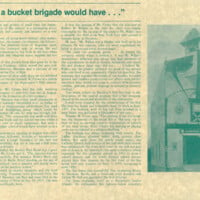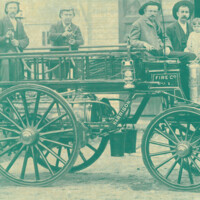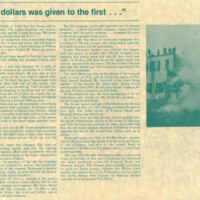Even a bucket brigade would have satisfied us
Transcript
"Even a bucket brigade would have..."The formation and growth of small town fire departments at the turn of the century is a fascinating story, large with tragedy and comedy and heroism on a very human scale.
Volunteers from all social levels without class distinctions ... the lawyer, the farmer, the minister, the laborer…all met at the primitive level of desperate need, committed to the common task of saving life and property from destruction by fire back in the days when modern equipment and adequate water supplies did not exist.
A prototype of this picture from days gone by is the old Harrison Fire Company, which served the area now occupied by downtown Harrison and a portion of the Town of Rye, now the City of Rye.
For a vivid picture of these early days, we are indebted to the memories of the late Emmett W. Crowe in a speech given on the occasion of the department's 50th anniversary in 1944.
At that time, Mr. Crowe was the only surviving member of the original 11 men who first met in August, 1894, to consider the formation of a fire company.
The Town of Harrison was a very small community in 1894 which was suddenly threatened with an influx of new citizens due to mushrooming subdivisions. The need for a disciplined firefighting group which could be counted on to answer all calls for help was strongly felt.
Mr. Crowe said, "Our community was small with little prospect of raising funds and we did not envision either a building of our own or much equipment. But even a bucket brigade under control would have satisfied us as a starter." And so the preliminary meeting in August was called and more meetings followed. Articles of incorporation were prepared and a rough boundary of the new fire company's responsibility was set at one and a half miles from the Harrison Station.
This area included the Boston Post Road and a good deal further. As Mr. Crowe put it, "The distance was not measured very carefully. For instance, Robert Beck, son of the proprietor of Becks Hotel standing on the site of what is now Playland, was a member and nearly every able-bodied man in the territory joined."
Sixty-eight joined as charter members and the total reached 125 shortly. Consents were procured from the Town Boards of Harrison and Rye and were filed in the office of the Secretary of State on Jan. 10, 1895. The new fire company was officially born.
It was the opinion of Mr. Crowe that the selection of Robert R. Willets as the first fire chief was largely responsible for the success of the venture. Mr. Willets was a wealthy fire buff from New York City who owned a summer home in Harrison.
He said, "Mr. Willets was a Quaker and lived up to his religion. He was tolerant, calm and never emphasized his belief or desires and never showed anger. "
He ruled the company gently ... he loaned the company money when it needed it. It was Mr. Willet's instructions, influence and advice that lead members of the organization to lead an honest, temperate and moral life and deplore those who did not ... I believe Mr. Willets was the greatest influence for good of any person who ever lived in our community. Under his direction, the company knit together the people of our locality for miles around and families could attend our affairs with perfect assurance they would not come in contact with drunken rowdies, quarrels, profane language or unusual or immoral conduct."
This warm tribute to Harrison's first fire chief is also descriptive of the central position that a fire company played in the moral and social life of the community.
Funds were donated for the construction of the first Harrison fire house and volunteers went to work in June, 1895. The building, with its big hall floor polished to a satin finish, was dedicated in December of last year. Emmett W. Crowe says, "The opening of the fire house was the beginning of the social life of Harrison. Up to then we had no meeting room or organization of schools of any kind except Hope Chapel but dancing or playing cards was prohibited in a religious building." The building was always humming with activity. The Ladies Auxiliary planned public balls, picnics, clam bakes,. But aside from the purely social aspect, the Catholic Church held services in the hall until their church was constructed; the town held court in the hall and had two lock-ups in the basement; the same committee which organized the fire company started in 1895 to form a school district, and the newly formed school district started their first sessions on the first floor of the fire house with two teachers on Sept. 1, 1896, occupying it until 1898.
The fire house also housed the first circulating library in Harrison. Books and a bookcase were donated and George W: Hall was appointed the first librarian.
Far from confining itself to a disciplined bucket brigade, the enthusiastic fire fighters found voluntary...contributions sufficient to build their fire house and to buy their equipment. The Ladies Auxiliary was responsible for raising funds, and Mr. Crowe says that "We never received or asked a subsidy from the Town."
The first piece of equipment was a hand pump engine, with six hundred feet of hose and a hose reel, delivered in Nov., 1894. It was housed in a barn belonging to William R. Bull, and later in a barn of John W. Hiney, proprietor of the Harrison Hotel.
This engine and reel were hauled to fires by long ropes with up to fifty men pulling and pushing it along mud roads.
Later, however, a pole was attached for a team of horses. Mr. Crowe describes the procuring of a team to haul the engine with some humor. He says that at first three dollars was given to the first team to appear after the alarm sounded. "At first," he says, "teams came from all directions, but since only one got the money, this dwindled down until none showed up. Then we gave five dollars to the team attached to the pump and two dollars to the teams arriving late. It worked for a spell, but we were soon hunting for a team." This dilemma was finally solved by contracting for a team at $100 per year.
The first fire alarm was an old locomotive wheel hung on a tripod and struck with a hammer. Inadequate water supply was a big handicap in fighting fires. Finally, a land company erected a wooden water tank and ran a two inch pipe through their land and through some of the streets of the town. The bulk of the water mains, however, were installed in 1904.
True fire buffs, one and all, Mr. Crowe reminisced that "We ran to many fires within the district and sometimes out of the district. We didn't want to miss a fire. And one time, we sounded an alarm and got all het up over the northern lights."
A decade later, times had changed. The town of Harrison was growing rapidly and new fire fighting equipment was needed. Motorized equipment was replacing the horse-drawn trucks in the larger communities and was proving far more efficient.
It was felt by the members of the old fire company that if the taxpayers wanted fire service, they should pay an equitable share of the expense. Equipping a modern fire department was rapidly growing beyond the money-raising capacity of the Ladies Auxiliary.
And so, on April 10, 1911, a meeting of the town's electors, 76 of them, voted for a water district and for the formation of an exempt fire company. The Town Board purchased the old fire company for $3,500, a sum including the fire house, the hook and ladder, patrol wagon, hoses and all appurtenances.
The fire company, previously organized into its present divisions... a hook and ladder company, engine and hose company and fire patrol company remained the same in the newly organized department.
In 1918, the first piece of motorized equipment was purchased, a 500 gal. pumper, and, along with it came the first paid fire driver for the department.
Today, Harrison's modern and efficient fire department has grown to include two 750 gal. pumpers, one chemical and patrol truck and one 85 foot hook and ladder. A modern 100 foot hook and ladder truck was recently approved by the voters. The department now has nine paid fire drivers and 146 volunteers, organized in the same three companies.
The most disastrous fires in the history of the town all came at once, in 1921, and all during the regime of Fire Chief Harold Studwell. Mr. Studwell is the oldest living member of the present fire department, having served continuously since 1905. He was department treasurer for the past 35 years, a position he now holds.
In this disastrous year, the most humiliating of all fire experiences rests heavily on Mr. Studwell's memory ... the fire house burned down.
The former center and hub of Harrison's social life was demolished on Oct. 11, 1921 during a howling 60 mile an hour gale. The entire corner of Fremont Street and Harrison Avenue was wiped out.
As if that were not bad enough, several months later the former Presbyterian church at the corner of Harrison and Park Avenues was reduced to ashes. And following this, the old movie house in the block of Halstead Avenue opposite the site of the present post office, went up in smoke.
Of recent years, two fires at the Westchester country club in Harrison early this spring were the most severe test of the efficiency and skill of the present band of volunteers of the Harrison Fire Department ... a test they passed superbly.
The year 1921 brought fire disasters galore to the small town. In October of that year a firehouse fire destroyed the entire southwest corner of Fremont Street and Harrison Avenue. The firemen unsuccessfully attempted to quell the flames during a 60-mile gale. Within a few months fires started first at the Presbyterian church and at the movie theatre then located on Halstead Avenue opposite from the present Post Office.
Description
This article from Harrison's Early Days, a collector's item published in 1976 to commemorate the United States Bicentennial, details the early history of the Harrison Fire Department.
Date
1976
Subject
Harrison Fire Department
Publisher
Union Savings Bank of New York
Type
Text
Contributor
Dawson, Charles F.
Language
en-US
Rights
This material may be protected by the U.S. Copyright Law (Title 17, U.S.C.). Fair use of this content is permitted as defined by copyright law. Responsibility for determining fair use lies with the user. The user is responsible for any claims that may arise.
Citation
“Even a bucket brigade would have satisfied us,” Harrison Remembers, accessed April 29, 2024, https://www.harrisonpl.org/harrison-remembers/items/show/407.




